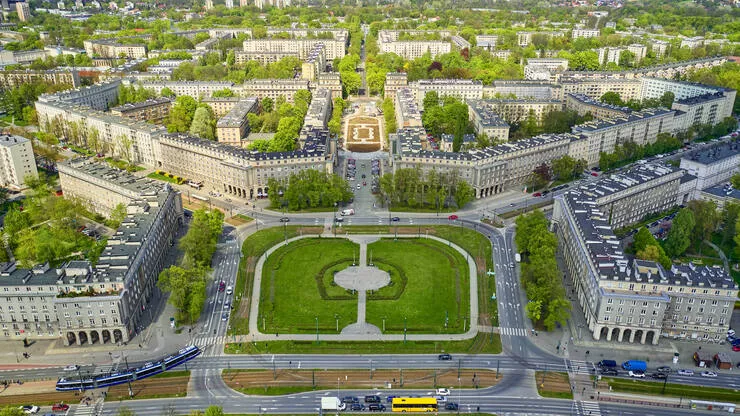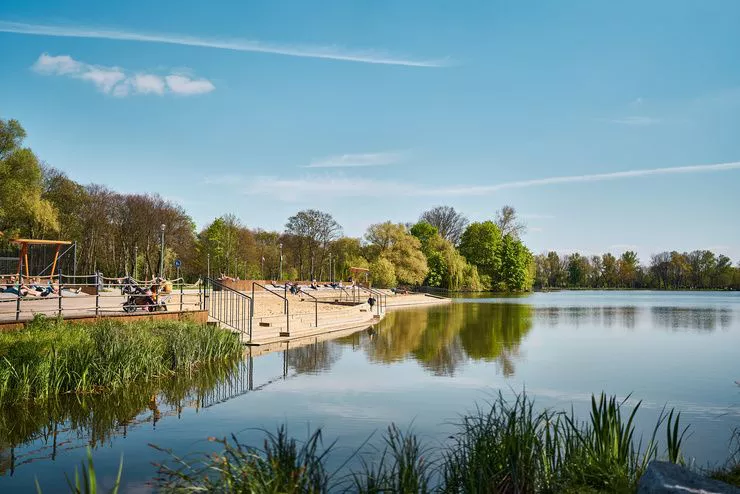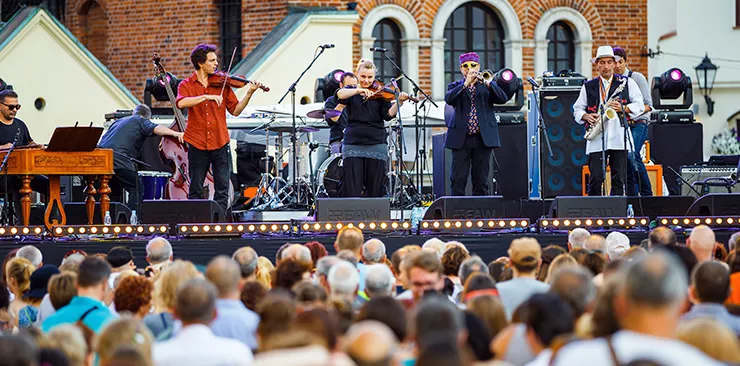





Welcome to Jungle, no Longer Concrete.
Nowa Huta, intended to provide housing for the Lenin Steelworks, is literally “New Steelworks”. Named also “the city without God” it was decreed by Stalin to feed the Comecon economy.

Luckily, against the best laid schemes of the communists, the workers residing in this jungle of grey rows upon rows of blocks, perhaps the most archetypal in the whole of the Eastern Bloc, rebelled. Nowa Huta became a district of Kraków and has slowly though literally grown into its opposite: regularly designed estates separated with broad tree-lined lanes, plenty of greenery, and unique modern churches.
It can’t just be believed and needs seeing, right? Best after perusing some Nowa Huta aficionado websites, or in a company of a local guide, who can help you learn more about a city-turned-district that started as a mad plan of building the world’s Satanic Mills on the orchards growing on region’s most fertile soils. This is but one of dozens of legend-like stories that are best heard when walking among what some still remember as huge slabs of concrete among the mud predating the spacious streets and lawns. When walking under sixty-year-old trees that have given Nowa Huta an entirely new guise.
The change of the living environment is not the only unexpected turn that Nowa Huta took. Intended and designed as a city without God, and consequently with no churches, it now has a fair number of those, most of them very large to cater for the throngs of parishioners and very attractive not only visually. The Ark of the Lord (Arka Pana) Church built in the shape of St Peter’s boat impresses with the 25-foot-tall sculpture of Crucified Christ inside, while its tabernacle is decorated with a stone brought from the Moon by Apollo 11 astronauts.
A great destination for a leisurely walk is the spared Manor House of Jan Matejko the painter. It stands by the Zalew Nowohucki reservoir recently turned into a great leisure spot. Eager to let your feet rest and give your arms a good workout, you can try your hand (with or without an instructor) at paddling the Dłubnia-Nowa Huta Kayaking Route, which starts here. Even if the course is but 3 miles long, it can take up to 2 hours due to the many obstacles, mostly fallen trees and shallows but also some mini rapids, making it attractive for children as well. The adventure ends where you sail out into the Vistula River.
If your feet have rested, take a walk from here, preferably across the Lasek Nowohucki (Mogilski) forest, in what used to be villages surrounding the area, now making the outskirts of Nowa Huta. Certainly worth visiting are the grand 13th-century Cistercian Abey and Monastery with miraculous crucifix and Renaissance frescoes and the beautiful miniature 15th-century wooden Church of the Nativity of Jesus and St Bartholomew the Apostle standing on the other side of the street in the village-now-district of Mogiła.
As the road goes on and on, you can pursue it with eager feet to many attractive corners of Nowa Huta. And if by now you have become hungry or thirsty, check the most famous restaurant looking back to the old days. Stylowa is just off the pedestrian extension of the Central Square (now plac Ronalda Reagana) by which you can also find the Centralny Milk Bar. The Cocktail Bar’s sadly gone, but they say that Kawiarnia Centrum in the Central Square decently makes up for it. If, however, you prefer to eat elsewhere, check another recommendation by clicking here!
To see the sheer size and some installations of the Satanic Mills of formerly Lenin and now Arcelor-Mittal Steelworks, either climb the Celtic Mound of Queen Wanda, or take a tram to the “distant” end of the Grębałów Cemetery. Visiting the latter after dusk, especially on or around 1 November, is quite an experience, as Poles light multiple candles on their relatives’ graves. Multiplied by the thousands of graves, they turn the hillside into an ocean of flickering lights.
Find the bomb shelters built in the days of the Warsaw Pact to protect people against NATO bombs. A guided tour takes you 70 years back in time, and helps to see the world through Cold War eyes. Could we be so bold as to suggest doing it with the Rawelin aficionados of history and reenactment?
“Come with us, Comrade” walks and rides in communist-era Trabis and Little Fiats might be fewer than at the height of their popularity, yet why not join one?








